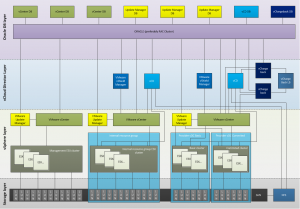A vCloud infrastructure consists of several components. Many of you have deployed, managed, installed or designed vSphere environments. The vCloud Director architecture introduces a new and additional layer on top of the vSphere environment.

I have created a diagram which depicts architecture mainly to be used by service providers. Service providers are likely to use an internal cloud for their own application and IT department operations and an external cloud environment for their service delivery.
The purpose of this diagram is to create a clear overview of the new environment and showing a relational overview of all the components. In essence, which component connects with which other components?
The environment consists of a management cluster, an internal resource group and an external resource group. Building blocks (VMware vSphere, SAN and networking) within a vCD environment are often referred to as “resource groups”.
To run a VMware vCloud environment, the minimum components to run are:
• VMware vCloud Director (vCD)
• VMware vShield Manager
• VMware Chargeback
• VMware vCenter (supporting the Resource groups)
• vSphere infrastructure
• Supporting infrastructure elements (Networking, SAN)
The management cluster contains all the vCD components, such as the vCenters and Update managers managing the resource groups, the vCD cells and Chargeback clusters. Due to the Oracle Database requirement, a physical Oracle cluster is recommended, as RAC clustering is not supported on VMware vSphere. No vCD is used to manage the management cluster, management is done by a dedicated vCenter.
Within a resource pod a separate cluster is created for each pVCD to enable the service provider to deliver the different service levels. Duncan wrote a great introduction to VCD recently. http://www.yellow-bricks.com/2010/08/31/vmware-vcloud-director-vcd/.
This diagram shows two additional vCenters, one for the internal resource pod and one for the external resource pod. It is advised to isolate internal IT resources from customer IT resources. Managing and deploying internal IT services and external IT services such as customers VM from one vCD can become obscure and complex. A single vCenter is used for both pVCDs as it expected that customer will deploy virtual machines in different service level offerings. By using one vCenter a single Distributed Virtual Switch can be used, spanning both clusters\service offerings.
To rehash, this is a abstract high level diagram intended to show the involved elements of a vCloud environment and to show the relation or connections all the components.
Thanks Frank.
As said, ‘A Picture speaks a Thousand Words’ – This vCD picture makes the concept clear and easy understanding, except the vSphere layer with more cluster (Committed / Basic / Management).
Hi Frank, just in case you have missed them, Hany Michael of VMware also made two very detailed vCloud diagrams: http://www.hypervizor.com/diagrams/
Excellent diagram..makes easy sense of lots of reading